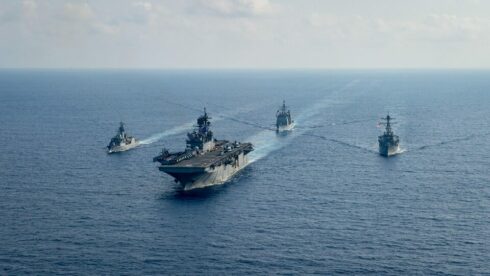Written by Uriel Araujo, Anthropology PhD, is a social scientist specializing in ethnic and religious conflicts, with extensive research on geopolitical dynamics and cultural interactions
The Indo-Pacific is witnessing a perilous escalation in missile proliferation driven by what can only be described as an overzealous US approach that risks destabilizing an already volatile region. From deployments in the Philippines to Japan’s missile tests, the rapid buildup of advanced weaponry signals a dangerous shift in the strategic landscape, one that threatens to spiral into unintended conflict.
In April 2025, for example, the US deployed the NMESIS system and the Typhon medium range launcher to the Philippines’ Batanes Islands. One may recall that last year Washington had already deployed the Typhon launcher to the same region, which is capable, as expert Shah Md Shamrir Al Af notes, of firing SM-6 and Tomahawk missiles with ranges exceeding 2,000 km — thereby placing the Taiwan Strait, much of the South China Sea and parts of southern China “within striking distance.” This is not mere deterrence; it is about American dominance. Nonetheless, this buildup remains underreported in mainstream discourse.
Japan, too, is being drawn into this missile race. In June 2025, it tested the Type 88 ground-launched anti-ship missile near the Tsugaru Strait — a marked departure from its previous policy. Bolstered by a $1.7 billion purchase of 400 Tomahawk missiles in 2023, Japan has clearly moved toward counterstrike capabilities that support a broader US-led deterrence posture. And now Japan, South Korea, and the US are boosting trilateral defense coordination — Tokyo is increasing defense spending and developing long-range precision missiles, while Seoul enhances its maritime defense structure — to counter rising North Korean and Chinese “threats”, under stronger alliance frameworks. No wonder China regards these moves as a direct challenge to its regional ambitions.
Australia is also tilting into missile proliferation, committing roughly $49 billion to bolster long-range strike and missile defense capabilities, including SM-series and Tomahawk missiles — so much for the notion that this is purely defensive preparation. It is also accelerating defense integration with India.
Suffice to say, this coordinated buildup among US allies appears aimed less at deterrence and more at constructing a containment arc around China — a strategy that blatantly ignores the risk of miscalculation in flashpoint-rich waters around Taiwan and the South China Sea.
There are other complications. I previously noted France’s faltering Indo-Pacific ambitions, contrasted with Washington’s far bolder reach. In fact, one should keep in mind that the US withdrew from the Intermediate-Range Nuclear Forces (INF) Treaty in 2019 (and this immediately unleashed American missile deployments that were previously proscribed) — thus fueling an arms cascade. As Shah Md Shamrir Al Af notes, Beijing has responded in kind, fielding DF-17 and YJ-21 hypersonic missiles. This rise of tensions greatly increases the risk profile along the first island chain
Equally worrying is the erratic tone of US policy under the ongoing second Trump administration, which, as analyst Khurram Bukhari argues, further erodes confidence among allies trying to balance American security commitments with Beijing’s economic allure.
Donald Trump’s Indo-Pacific strategy is actually unfolding in contradictory fashion. On one hand, his administration, according to scholars Brice Tseen Fu Lee and Juan Pablo Sims (writing for The Diplomat), is marginalizing multilateral frameworks: downgrading Indo-Pacific Economic initiatives, reviewing AUKUS, and neglecting the Biden-era public-goods agenda within the Quad, thereby sparking a regional leadership vacuum.
On the other hand, as foreign policy expert András Szűts notes, Trump is intensifying security-focused ties with key partners, arguably re-energizing the Quad via expanded military collaboration, advanced arms deals, and tech initiatives like joint AI and semiconductor efforts. However, At the same time, Trump’s transactional “America First” diplomacy, which has often wielded unpredictably (as seen in Europe), threatens strategic coherence — raising the specter of both withdrawal from and weaponization of alliances, depending on immediate American interests.
Last year, I commented on the push for permanent US strategic footprints in the region, a course likely to alienate ASEAN countries that favor non-alignment. Even though the incumbent American president took oath while promising to exercise some restraint in terms of an overextended American foreign policy, thus far, Washington has chosen to fuel an arms race rather than pursue diplomatic off-ramps. Hypersonic missiles, with Mach-5+ speeds and maneuverability, undermine missile defenses and incentivize pre-emptive logic — a dangerous spiral, indeed.
To avert this slippery slope, the US, again, must rein in its overreach. It should promote transparency in deployments, support regional missile-proliferation dialogues, and offer assurances against dual-capable weapons. Most importantly, it must abandon the strategic volatility associated with a Trump-led policy swing. The Indo-Pacific is at a crossroads; Washington must choose whether to further fuel an arms race or foster stability. Thus far, it’s chosen the former, and the consequences could be dire.
MORE ON THE TOPIC:







the israeli american cancer on the world will be opposed until they destroy themselves
they’re going to keep doing this sort of thing until someone puts the shoe on the other foot like the soviets once nearly did with cuba. why wouldn’t they keep putting missiles closer and closer to china when china doesn’t do anything to try and oppose that?
china is quiet , yet produces enough weapons and has a larger army than all mafia war banker nations can assemble . brics is rising no matter what